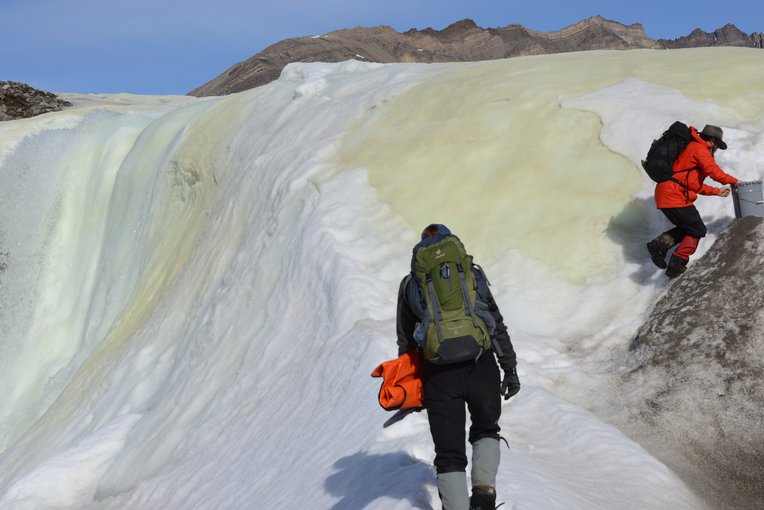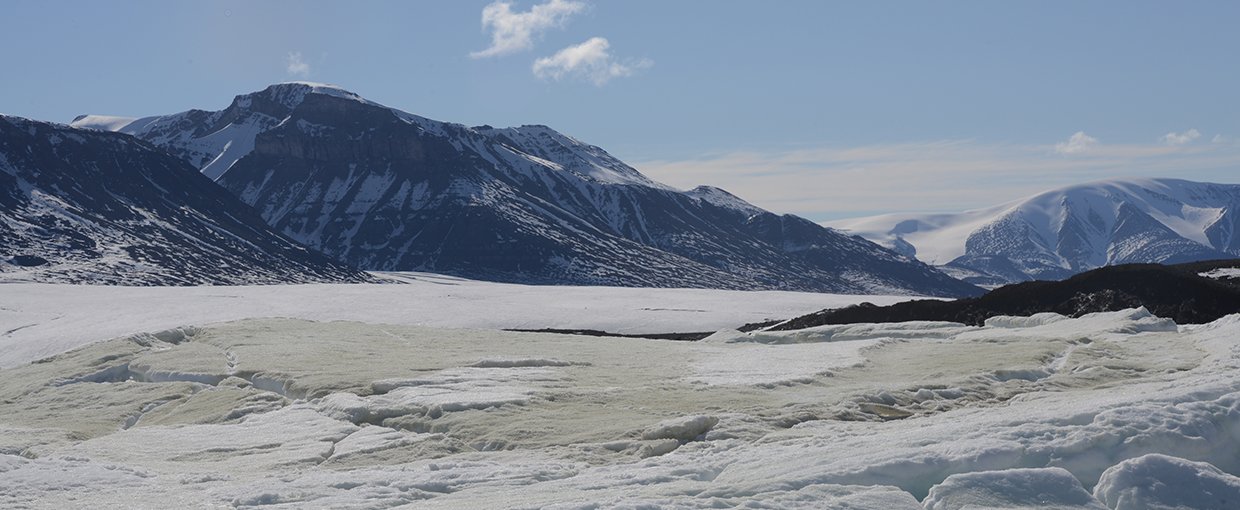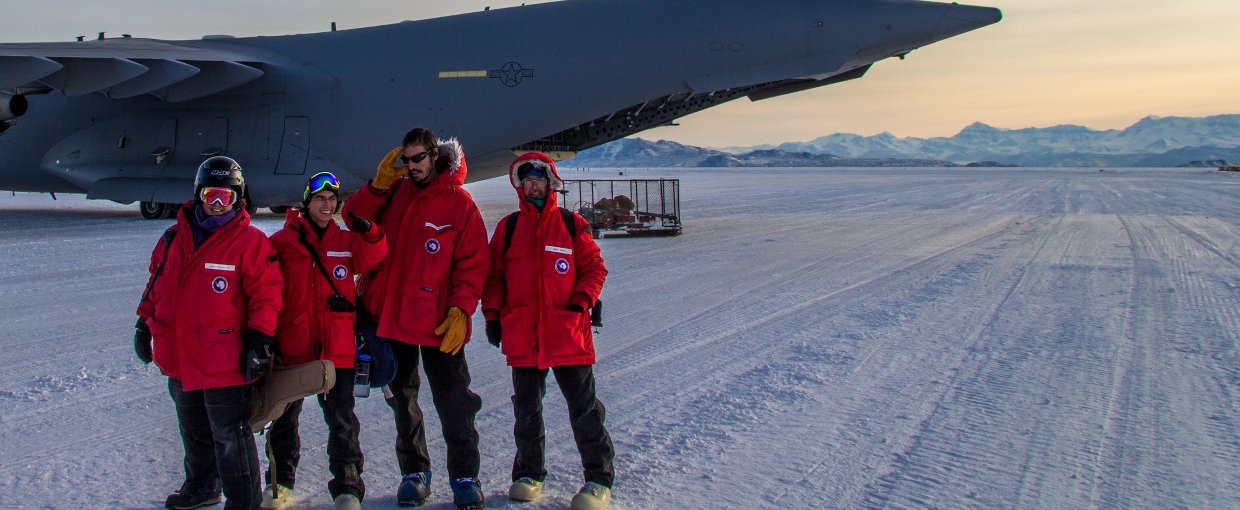Written byKeith Cooper

The icy moons in the Outer Solar System, which have sub-surface oceans beneath crusts of ice, could be promising spots for life. Yet, their location outside the ‘habitable zone’ is a departure from what has traditionally been viewed as the best place to look for life.
As such, these moons – including Jupiter’s moon Europa, Saturn’s moons Enceladus and Titan, and perhaps even Neptune’s moon Triton – are providing fresh challenges and opportunities for astrobiologists. In order to better understand these icy worlds, planetary scientists and astrobiologists are conducting fieldwork in remote locations on Earth that act as analogs to these extraterrestrial environments.
In the wake of high resolution imagery from NASA’s Galileo mission to the Jovian system, scientific consensus has begun to converge that deep beneath Europa’s ice is a global ocean of water. The evidence includes signs of chaos terrain on the surface that indicates sub-surface melting [1, 2], ridges that may have formed from upwelled material, and a weak magnetic moment that is induced in the ocean by Jupiter’s magnetosphere and was first detected by Galileo [3]. Reddish-brown markings, or stains, seen in the ice around both the ridges and chaos terrain suggest the material has convectively risen to the surface from the ocean below. Spectroscopic observations, most recently conducted with the OSIRIS spectrograph on one of the 10-meter telescopes at the W. M. Keck Observatory in Hawaii, have identified an unknown material – possibly salts left over from ocean water that has risen to the surface – in the vicinity of the chaos terrain [4], along with iron and sulfur. Such material, in theory, could include organic compounds and inform scientists about the chemistry of the ocean.

A gypsum paleopipe emerges out of a moraine of glacial talus on the south side of Borup Fiord Pass glacier. The paleopipes are distinct for their gypsum and variable mineral coloring amidst the talus.Image credit: John Spear.
To coordinate research on the Galileo data, the Europa Focus Group (EFG) was formed in the 1990s, chaired by Ron Greeley of Arizona State University [5]. The EFG was later superseded by the Habitability of Icy Worlds group at NASA’s Jet Propulsion Laboratory (JPL). Greeley and Max Coon of Washington State University, both of whom have since passed away, organized the first field trip to a Europan analog site in April 2003 in Barrow, Alaska with a team of 20 scientists of various disciplines, including microbiologists, geologists and planetary scientists. The team studied ice ridges and sea ice [6] by going onto the ice and viewing the ice from above. Greeley aimed to demonstrate that such environments are complex and assumptions shouldn’t be made about icy moons on the basis of their gross appearance. Among the scientists who travelled to Barrow was Bob Pappalardo, now the Europa Mission project scientist at JPL.
“It was the first time that the Europa community collectively started thinking about analog environments,” Pappalardo says. “I honestly think that sea ice is not the right analog, but at the time – and maybe still today – there were some who thought it could be a good analog in some respects. But having a bunch of scientists up there on the ice, experiencing it first hand and discussing it, went a long way. The heritage of that can now be seen in Britney Schmidt’s work on Antarctic ice shells as an analog.”
Schmidt, of the School of Earth and Atmospheric Sciences at Georgia Tech, leads teams to the McMurdo ice shelf in Antarctica, most recently in November 2015 for the SIMPLE (Sub-ice Investigation of Marine and Planetary-analog Ecosystems) project [7]. Funded by NASA’s Astrobiology Science and Technology for Exploring Planets (ASTEP), the project seeks to uncover more about the ecology that exists at the boundary between the underside of Antarctic ice shelves and the ocean below, and how that understanding can be applied to icy moons like Europa. The SIMPLE project epitomizes many of the key facets of analog-site fieldwork: aerial or orbital mapping using ice-penetrating radar, Lidar and laser altimetry, visual and spectral mapping, and gravity-sensing. These technologies are followed by on-site validation to provide ground-truth, as well as deployment of the ARTEMIS submersible for in situ measurements and retrieval of samples for laboratory study.

The sulfidic outcrop on the toe of the Borup Fiord Pass glacier. This image looks south with the sulfur icings spreading eastward.Image credit: John Spear.
“For icy worlds, folks are mostly working on extremophiles in various places – meteoric ice, sea ice, frost flowers, frozen or permanently covered lakes – and these are thought to have some of the evolutionary strategies of organisms in extreme cold,” says Schmidt. “A few others study the environments themselves – the ocean, the ice, their dynamics – and how those relate to environments on icy worlds.”
On Europa, the colored markings associated with the chaos terrain contains sulfur and iron, leading planetary scientists to conclude that the ocean below is also rich in these chemical elements. On Earth, we have just two known analog sites that mimic the presence of sulfur or iron on ice: Blood Falls on Taylor Glacier in Antarctica, where an iron-rich spring creates a blood-red frozen waterfall over the lip of the glacier; and the Borup Fiord Pass on Ellesmere Island within the Canadian High Arctic Circle, where a sulfur-rich spring passes under glacial ice before emerging onto the surface, instigating some interesting biochemistry.
The astrobiological importance of Borup Fiord was discovered by Steve Grasby of the Geological Survey of Canada (part of the Earth Sciences Sector at National Resources Canada) when flying over the region in the 1990s. He noted a large, yellow stain on top of the glacier that turned out to be elemental sulfur. A decade later, Grasby teamed up with several more scientists who took an astrobiological interest in Borup Fiord. Among them were biogeochemist Alexis Templeton of University of Colorado, Boulder and microbiologist John Spear of Colorado School of Mines.
“We don’t usually find elemental sulfur associated with ice, so we started up a dialog and eventually we got people on the ground to actually see what the site was like and since then research at Borup has really expanded,” says Spear.
The team discovered that hydrogen sulphide in the spring, originating from an evaporite in the sub-surface, probably gypsum, is re-oxidizing into yellow elemental sulfur on the ice. It is the only location on Earth where this process takes place on ice and Spear and Templeton’s team are confident that both biotic and abiotic processes are occurring there to oxidize the sulfur, although the biotic processes are dominating.
“Sulfur and iron are both important elements for life,” says Spear. “Both can act as electron donors in order to serve as energy sources, or they can act as electron acceptors to provide energy sinks. In other words, they can be something to fuel life or something for life to breath.”

Another day of sampling – Graham Lau (right) of the University of Colorado at Boulder ascends the toe of the sulfidic outcrop on Borup Fiord Pass glacier while Alexis Templeton awaits the gooey slick climb.Image credit: John Spear.
DNA found in samples taken from the region and extracted via 16/18S rRNA gene sequencing indicate that the bacteria are sulfur-metabolizing and sulfur-oxidizing microbes and include Ralstonia spp., Thiomicrospira spp., Sulfuricurvales spp., Sulfuriovumales spp. and Marinobacter spp. When the latter was being cultured, it bio-mineralized elemental sulfur along the filaments and cell sheaths, and the sulfur showed a clear biogenic structure. The hope is that a structure like this could act as a possible biosignature detectable from orbit, once technology advances [8], [9].
If microbes are oxidizing the sulfur seen on Europa’s surface, it could provide a way to detect life in the ocean without drilling down into it. NASA’s upcoming Europa mission, set to launch next decade, is not expected to carry a lander, so remote sensing from orbit will be important in determining the nature of the sulfur on Europa.
Already, some work has gone into experimenting with remote sensing at Borup Fiord. Damhnait Gleeson, formerly of JPL and the European Space Agency’s Centro de Astrobiología in Spain, visited Borup Fiord in 2007. Funded by a grant from the Lewis and Clark Fund for Exploration and Field Research in Astrobiology, Gleeson’s research was to use images from the orbiting Earth Observing-1 spacecraft to identify sulfur compounds, followed by a trip to Borup Fiord to confirm that those compounds really are present and to search for anything the satellites might have missed [10]. This work helps to improve the accuracy of remote sensing by using ground-truth to calibrate instruments, thereby boosting confidence in data retrieved by a spacecraft orbiting Europa or another icy moon.
NASA presently has a spacecraft visiting an icy moon in Cassini, which orbits Saturn and regularly flies by Enceladus. The link between the fieldwork at analog sites and the Enceladus flybys is not a direct one, however.

John Spear sniffs sulfide (the human nose is sensitive to 2 ppb sulfide!) from a bubble on a surface pond on the Borup Fiord Pass Glacier.Image credit: Christopher Trivedi.
“When planning our Cassini flybys we mostly consult the Cassini scientists themselves,” says Cassini’s project scientist Linda Spilker of JPL. “Some of them may be talking to other scientists working on data from Antarctica or Greenland but these scientists are not regularly consulted by the [Cassini] project. However, terrestrial analogs are what we use in making comparisons to other worlds in our solar system, so these analogs are very important to understanding the Enceladus data.”
The chief obstacle of fieldwork at analog sites is funding. A visit to Borup Fiord can cost upwards of $10,000 per person; a visit to Antarctica is even more expensive. It is not just the expense that makes these grant proposals difficult to win: successful applications must also make the case that this research can only be conducted at an analog site and not in the laboratory or somewhere closer to home. Schmidt estimates that just 10 to 15 percent of all proposals are funded. The United States Antarctic Program also has to balance its resources throughout the year, so opportunities are limited, even for the most deserving projects.
Another pressing concern is the narrowing window of opportunity for studying these analog sites, particularly at Borup Fiord. Between site visits in 2014 and 2015, Steve Grasby noted an extra several hundred meters of glacial melt that could be tied to climate change. The fear is that in a decade or two, the Borup Fiord site could melt away completely. This has happened previously: on the glacial moraines at Borup Fiord where the glaciers used to be, there are numerous fossilized springs known as paleopipes where all that remain are holes in the ground with a yellow–orange coloring that is sulfur-based.
“Over 100 years ago we might have seen 50 sulfur springs on the ice and now we’re down to just one,” says Spear. “It is a concern, because it is like losing an endangered species. Once it has gone, it has gone, and we would have just lost an opportunity to understand something that is in our solar system.”
Now that NASA has earmarked funds for the development of a mission to orbit Europa, the community hopes that more funds will be made available to increase fieldwork at analog sites, particularly if it can be shown that the fieldwork is directly related to the mission. As a case in point, Schmidt won funding for the SIMPLE project partly to help calibrate the ice-penetrating radar that will fly on the Europa mission in the form of REASON, the Radar for Europa Assessment and Sounding: Ocean to Near-surface (REASON), that is led by Donald Blankenship of the University of Texas, Austin,with Schmidt as a co-investigator.

Expeditions to Antarctica do not come cheap, with the SIMPLE team flying there on a Boeing C-17 transport plane. Britney Schmidt is seen on the far left.Image credit: Justin Lawrence/SIMPLE.
Technology is also being tested for missions beyond NASA’s current Europa orbiter plans. The ARTEMIS (Autonomous Rover/airborne-radar Transects of the Environment Beneath the McMurdo Ice Shelf) vehicle, that was built by eight participating institutions for the SIMPLE project, is a long-range submersible designed to go beneath the ice and perform a number of experiments, including mapping the underside of the ice shelf to help calibrate the ice-penetrating radar results. The most recent tests in November 2015 saw ARTEMIS descend five kilometers beneath the sea ice and then travel a kilometer under the ice shelf. ARTEMIS, and vehicles like it, such as VALKYRIE (Very deep Autonomous Laser-powered Kilowatt-class Yo-yoing Robotic Ice Explorer), are prototypes of vehicles that will one day explore beneath the ice on worlds such as Europa and Enceladus.
The fieldwork carried out by planetary scientists and astrobiologists at analog locations that mimic specific conditions or processes found on icy worlds lays the foundation for ways in which their exploration fits into the overall strategy of NASA’s Astrobiology Program. Studies at Borup Fiord, for example, help to identify abiotic compounds that result from reactions associated with life; ground-truth expeditions help to identify and characterize bio-signatures and their environments; exploring the sub-surface ecosystems can indicate the evolutionary processes and adaptions that can allow life to survive in possibly stressful environments for millions or even billions of years; and the exploration of the ocean below the ice will help with the conceptual construction of habitable worlds.
It should be noted, however, that fieldwork is no substitute for exploring the real thing. The surfaces (and oceans) of icy worlds may be so diverse that no one location on Earth can be truly analogous. However, studies at analog sites complement current missions, such as Cassini’s, while paving the way for a fuller understanding and exploration of moons like Europa or Enceladus in the future. Fieldwork at analog locations is an example of comparative planetology. While the principal aim is to understand the icy moons of the Solar System, the research also teaches us about ecosystems in difficult environments on our own planet.

The ARTEMIS submersible vehicle being lowered into the water, where it will descend several kilometers below the McMurdo Ice Shelf.Image credit: Justin Lawrence/SIMPLE.
[1] Carr et al; ‘Evidence For A Subsurface Ocean on Europa’, Nature, 391, 363–365 (1998).
[2] Schmidt BE, Blankenship DD, Patterson GW, Schenk PM; ‘Active Formation of Chaos Terrain Over Shallow Subsurface Water on Europa’, Nature, 479, 502–505 (2011).
[3] Zimmer C, Khurana KK and Kivelson, MG; ‘Subsurface Oceans on Europa and Callisto: constraints from Galileo Magnetometer Observations’, Icarus, 147 (2), 329–347 (2000).
[4] Fischer PD, Brown ME and Hand KP; ‘Spatially Resolved Spectroscopy of Europa: The Distinct Spectrum of Large-Scale Chaos’, The Astronomical Journal, 150 (5), (2015)
[5] https://nai.nasa.gov/focus-groups/past/europa-focus-group/
[6] https://nai.nasa.gov/articles/2003/5/15/nai-europa-focus-group-visits-arctic-ice-field/
[7] http://schmidt.eas.gatech.edu/simple/
[8] Gleeson DF, Williamson C, Grasby SE, Pappalardo RT, Spear JR and Templeton AS; ‘Low Temperature S^0 Biomineralization At A Supraglacial Spring System in the Canadian High Arctic’, Geobiology, 9, 360–375 (2011).
[9] Wright KE, Williamson C, Grasby SE, Spear JR and Templeton, AS; ‘Metagenomic Evidence for Sulfur Lithotrophy By Epsilonproteobacteria as the Major Energy Source For Primary Productivity in a Sub-aerial Arctic Glacial Deposit, Borup Fiord Pass’, Frontiers in Microbiology, 4, 63 (2013).
[10] Gleeson DF, Pappalardo RT, Grasby SE, Spear JR; ‘Borup Fiord: A Unique Glacial Environment of Astrobiological Significance and Potential Analogs to Europa Exploration’, 37th Lunar and Planetary Science Conference, p 1854.


